Photographs here, and related pages, are mostly in 3D, using anaglyph techniques which combine two photographs one in red and the other in cyan (blue + green) color. To get the 3D effect, you must use glasses with red and cyan lenses (filters) over your regular glasses. The form of the beak is far easier to interpret in 3D and we strongly recommend to the viewer that the glasses be obtained (this is especially helpful when viewing enlarged images - i.e. click on the image). These beak photographs were made using Red and Cyan Anachrome Aviator Glasses (see: http://www.anachrome.com/glassbuy.htm or http://www.amazon.com) which cost under $10.00 (USD).
Go to Tripartite Upper Beaks
Go to 1° Unipartite Upper Beaks
Go to 2° Unipartite Upper Beaks
Go to 3° Unipartite Upper Beaks
Go to Atypical Upper Beaks
This classification of beak type is based solely on the structure of the Shoulder. Other important features of the beaks are treated with family or generic characteristics.
UPPER BEAK TYPES
The upper beak of the "living fossil" Vampryoteuthis infernalis has a Shoulder consisting of three major components: (1) An Outer Part, consisting mostly of membranous tissue but with a small, pigmented Shoulder Blade; (2) a thick Middle Part consisting of translucent Hyaline Matrix that is covered dorsally by the pigmented Bridge and (3) a pigmented Inner Part, the Palatoshoulder Ridge, which is the anterolateral portion of the Lateral Wall.
All cephalopod beaks are formed by numerous very thin layers (perhaps with one layer deposited daily). These numerous, very thin layers generally group into the three major parts that form the Shoulder mentioned above. In young beaks most of these parts are unpigmented. except at the biting edges, but become gradually pigmented with growth. In the beaks most similar to that of Vampyroteuthis (i.e., Bipartite beaks), the Shoulder Blade is usually the first structure of the Shoulder to become pigmented (= sclerotized; i.e., the structure becomes progressively dehydrated and the proteins become highly cross-linked making this structure harder and tougher) followed by the Palatoshoulder Ridge. At a late stage in ontogeny, the Middle Part shrinks greatly as it becomes pigmented, and much of the remaining Outer Part of the Shoulder becomes pigmented.
When the shoulder is virtually unpigmented early in ontogeny or virtually fully pigmented in late ontogeny, shoulder types can be difficult or impossible to determine.
In decapodiforms we recognize three basic types of upper beaks (Bipartite, Unipartite and Tripartite beaks). In addition we recognize a fourth group of beaks (Atypical beaks) that don't fit into any of the basic types. All of these categories have the caveat that the definitions generally apply only to the broad (sometimes narrow) mid-period of ontogeny from early pigmentation of the beak to nearly full pigmentation.
Definitions for capitalized terms used below can be found here.
Bipartite Upper Beak: General trends
- Beaks tend to have an obtuse Jaw Angle with the free, anterior end of the Shoulder tilted posterior to the Jaw Edge and often straight or concave.
- Beaks tend to have a thin, simple Shoulder Blade.
- Beaks tend to lack any external (lateral) covering of the Shoulder Blade.
- Beaks tend to have a narrow (dorsal-ventral axis) Shoulder Blade.
BIPARTITE UPPER BEAKS
The Bipartite Upper Beak (most similar to that of the primitive Vampyroteuthis, see - Cephalopod Beak Structure and Evolution). The name is derived from having two pigmented structures in the Shoulder (Shoulder Blade and Palatoshoulder Ridge):UPPER BEAK CHARACTERISTICS:
- Step: Present in Type 1 and Type 3 beaks, absent in Type 2 beaks. Located between Palatoshoulder Ridge (or occasionally Hyaline Matrix) and Jaw Edge in Type 1 beaks.
Bipartite beaks lack a Step early in development but most develop one later. In some cases the Step may not develop until the beak is mostly pigmented. In relatively young beaks the free, anterior edge of the Shoulder Blade is the most anterior component of the Shoulder. Typically a Step forms during ontogeny by regression (often erosion) of the free edge of the Shoulder Blade which (since the Shoulder Blade is fused to the Hood at the Jaw-edge Extension) extends the Jaw Edge posteriorly; a gap (Step) is, thereby, formed between the Palatoshoulder Ridge and the Jaw Edge. The Step is accentuated by the continued growth of the Palatoshoulder Ridge. In the few taxa without a Step, the Shoulder Blade does not regress and the anterior edge of the Palatoshoulder Ridge never surpasses that of the Shoulder Blade.
- Shoulder Blade: Thin; on Outer Part of Shoulder, without an Outer Cover.
- Shoulder Blade: Composed of a single Component.
- Hyaline Matrix: Forms Middle Part of Shoulder.
- Palatoshoulder Ridge: Forms Inner Part of Shoulder except in Type 3 beaks where it is virtually absent.
- Yellow Line: Absent.

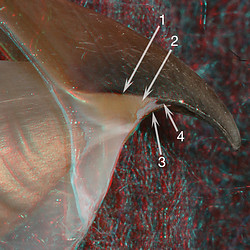
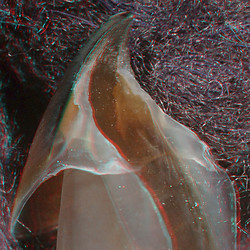

Figure. Mastigoteuthis microlucens, 95 mm ML, 3.2 mm URL. Left - Side view. Arrows: 1- Jaw-edge Extension. 2 - Shoulder Blade. 3 - Palatoshoulder Ridge. 4 - Step (emphasized by shadow). Middle - Oblique view. Right - Drawing of previous image.
Types of Bipartite Upper Beaks
- Bipartite Type 1 upper beaks
- Step: Present between Palatoshoulder Ridge (or sometimes Hyaline Matrix) and Jaw Edge at some point during ontogeny.
- Palatoshoulder Ridge: Well developed and anterior to Shoulder Blade.
Type 1 beaks occur in: Bathteuthidae, Chiroteuthidae (except Planctoteuthis), Mastigoteuthidae, Taoniinae, Gonatidae (except Berryteuthis, some Gonatopsis), Histioteuthidae, Psychroteuthidae, Neoteuthidae.
- Bipartite Type 2 upper beaks
- Step: Absent.
- Palatoshoulder Ridge: Well developed but not anterior to Shoulder Blade which generally precludes Step development.
Type 2 beaks occur in: Planctoteuthis (Chiroteuthidae), Magnapinnidae, Promachoteuthidae, Berryteuthis and some Gonatopsis (Gonatidae), Spirulidae, Bathyteuthidae.
- Step: Absent.
- Bipartite Type 3 upper beaks
- Step: Present.
- Palatoshoulder Ridge: Virtually absent, appearing only as part of general pigmentation of Shoulder.
At present Brachioteuthis cf. beanii is the only species known to have this beak type.
 Click on an image to view larger version & data in a new window
Click on an image to view larger version & data in a new window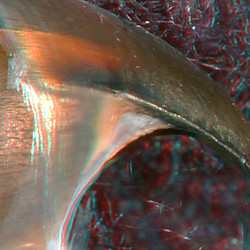
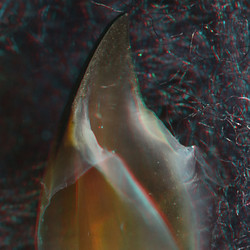
Brackioteuthis cf, beanii. Left - Side view, female, 114 mm Ml, 2.6 mm URL. In this beak a large Step is present, but the Inner Part is a composite in this nearly fully pigmented beak. Right - Oblique view, male 70 mm ML, 1.9 mm URL. This beak is pigmented enough that a Palatoshoulder Ridge should be present but there is no trace of one.
- Step: Present.

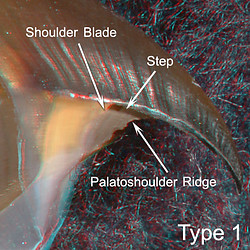
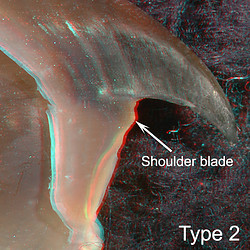
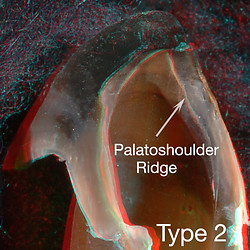
Figure. Bipartite Type 1 & 2 beaks. Left - Gonatus berryi, 124 mm ML, ? mm URL. The regression of the Shoulder Blade has left the Palatoshoulder Ridge in a relatively more anterior position creating a step. Middle, Right - Berryteuthis magister, ? mm ML, 5.9 mm URL. Middle - Side view. Although the Shoulder Blade is lost in the general pigmentation of the Outer Shoulder; no regression is obvious and no Step is present. Right - Oral-oblique view. The Palatoshoulder is well developed but doesn't reach the anterior level of the Outer Part of the Shoulder.
Bipartite Types 1 & 2: see upper beak- Structure.
Bipartite Types 1 & 2: see upper beak- Survey.
Tripartite Upper Beak: General trends
- Beaks tend to have an obtuse Jaw Angle but with convex shape to most of the anterior end of the Shoulder. Therefore, in profile, the free, anterior edge of the shoulder has an "S" shape but the main part of the shoulder is convex.
- Beaks tend to have a thick, complex Shoulder Blade.
- Beaks tend to have an external (lateral) covering of the Shoulder Blade.
- Beaks tend to have a broad (dorsal-ventral axis) Shoulder Blade
TRIPARTITE UPPER BEAKS
The Tripartite upper beaks get their name from having 3 pigmented structures in the Shoulder (Shoulder Blade, Palatoshoulder Ridge, Outer Cover of the Shoulder Blade).
UPPER BEAK CHARACTERISTICS:
- Step: Present. Located between Shoulder Blade and Jaw Edge; can be difficult to detect in small beaks. Note that this Step is different from that in Bipartite beaks. The Step can often be recognized early in ontogeny.
- Shoulder Blade: Thick; forms much of Middle Part of Shoulder; with partially translucent Outer Cover present. The Tripartite Shoulder Blade is not homologous with that of Bipartite or Unipartite beaks.
- Shoulder Blade: Consists of two major components. It is a single but folded structure that allows recognition of Inner and Outer Components. The Inner Component extends posteriorly onto the Free-shoulder and the Outer Component onto the Sessile-shoulder.
- Hyaline Matrix: Forms remaining Middle Part of Shoulder between Shoulder Blade and Palatoshoulder Ridge.
- Palatoshoulder Ridge: Present but reduced.
- Yellow Line: Absent. Outer Cover of Shoulder Blade thickest dorsally which looks vaguely similar to a Yellow Line.
There is only one type of Tripartite upper beak. This group includes most Onychoteuthidae, Enoploteuthidae and Lycoteuthinae.

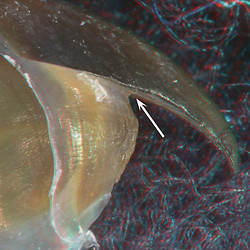
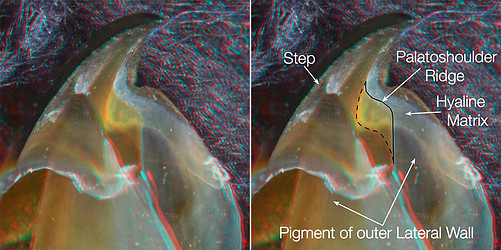
Figure. Oblique views, same beak as in top 3 images. Left - Side view. Dorsally the Shoulder Blade curves medially and anteriorly (arrow) to create the Step. Middle - Oblique view without any interfering drawing or text. Right - Same view. Palatoshoulder Ridge outlined with a solid line along the anterior and ventral edges and a dashed line indicating where the Ridge fuses with (= branches from) the rest of the Lateral Wall. Where the two overlap, they are separated by the Hyaine Matrix.
Tripartite Upper Beaks - Structure Tripartite Upper Beaks - Survey
Unipartite Upper Beak: General trends
- Beaks tend to have an acute Jaw Angle that gives them a convex anterior free-shoulder or, a least, a convex Tooth.
- Beaks tend to have a large, thick, complex Shoulder Blade.
- Beaks tend to have a deep (dorsal-ventral axis of Shoulder) Shoulder Blade
UNIPARTITE UPPER BEAKS
The Unipartite upper beaks get their name from having the appearance of only one pigmented structure (Shoulder Blade) in the Shoulder.
UPPER BEAK CHARACTERISTICS:
- Step: Absent. The Shoulder Blade forms the most anterior part of the Shoulder and it fuses smoothly with the Hood.
- Shoulder Blade: Thick; occupies outer-most major layer of Shoulder; in some 1° Unipartite beaks, partially covered laterally by thin layer of hyaline material.
- Shoulder Blade: Becomes complex during ontogeny when the first Shoulder Blade is joined by a second one. The latter develops medial to the first Blade and fuses with it although a line separating them is visible. The Shoulder Blade, therefore, becomes a double structure, with Inner and Outer Components, but in casual observation only one structure is apparent. Posteroventral pigmentation from Inner Component of Shoulder Blade extends onto the lateral surface of the Hyaline Matrix prior to converging with posterior Lateral Wall pigment during growth. This pigmentation pattern frequently contributes to the Lateral-Wall pigment having a saddle-shape.
- Hyaline Matrix: Forms Inner (= medial) Part of Shoulder.
- Palatoshoulder Ridge: Very reduced or absent.
- Yellow Line. Present in most 1° Unipartite beaks; possible counterpart (White Patch) present in some 1° and 2° Unipartite beaks.
The Unipartite Upper Beak is a feature of a large and diverse number of taxa. In general the evolution of the Unipartite beak from a beak very similar to the Bipartite beak has occurred independently many times. This group includes the Architeuthidae (?), Ommastrephidae, Thysanoteuthidae, Chtenopterigidae, Loliginidae, Sepiolida, some Brachioteuthidae, Joubiniteuthidae, Cranchiinae, Pyroteuthidae and Lampadioteuthinae.
Types of Unipartite Upper Beaks
- 1° Unipartite upper beaks
This category includes three taxa: Ommastrephidae, Thysanoteuthidae, Loliginidae. The Architeuthidae may belong here but data on structure is absent.
- Step: Absent
- Shoulder Blade: Thick; lateral (=outer) surface of Shoulder Blade with partial cover by thin layer of hyaline material.
- Shoulder Blade: Consists of two pigmented components (Inner and Outer), separated by a distinct line in a longitudinal cut.
- Formation of Inner Component of Shoulder Blade: Form in situ. Pigmentation of Inner Component is VISIBLE posteriorly where it extends onto the Hyaline Matrix during ontogeny BEFORE merging with pigment of the posterior Lateral Wall (i.e., a gap in pigmentation exists here during a period of growth). This gap, frequently contributes to the Lateral-Wall pigment having a saddle-shape.
- Hyaline Matrix: Forms Inner (= medial) Part of Shoulder.
- Palatoshoulder Ridge: Absent.
- Yellow Line: Present. Located between Shoulder Blade and Hood. Structure in Ommastrephidae differs from that of the other two families.
- Step: Absent
- 2° Unipartite upper beaks
This category includes two taxa: Sepiolida, Chtenopterygidae.
- Step: Absent
- Shoulder blade: Rather thick; lateral (=outer) surface of Shoulder Blade not covered by thin layer of hyaline material.
- Shoulder Blade: Consists of two pigmented Components (Inner and Outer); Components separated by a distinct line in a longitudinal cut.
- Formation of Inner Component of Shoulder Blade: Unknown. However, Saddle-shaped pigment of Lateral Wall during ontogeny, suggests de novo pigmentation of the Inner Component. PHOTO!!!
- Hyaline Matrix: Forms most to all of Inner (= medial) Part of Shoulder.
- Palatoshoulder Ridge: Very restricted to absent. Its status is uncertain in most taxa.
- Yellow Line: Absent. Possible counterpart (= White Spot) generally present. PHOTO!!!
- Step: Absent
- 3° Unipartite upper beaks
This category includes a variety of taxa, sometimes with little relationship in common, that have developed a Unipartite beak independently. It includes: Slosarczykovia (Brachioteuthidae), Joubiniteuthidae, Cranchiinae, Pyroteuthidae and Lampadioteuthinae. All share in common:
- Step: Absent.
- Shoulder Blade: Thin; lateral (=outer) surface of Shoulder Blade not covered by thin layer of hyaline material.
- Shoulder Blade: Consists of two pigmented components (inner and outer); components not separated by distinct line in longitudinal cut.
- Yellow Line: Absent; White Patch absent.
- Formation of Inner Component of Shoulder Blade: Varies greatly among taxa; often poorly known.
- Palatoshoulder Ridge: Greatly reduced to absent. Its status is uncertain in most genera.
- Hyaline Matrix: Forms Middle to Inner Part of Shoulder depending on taxa.
These taxa differ greatly in:
3° Unipartite Upper Beaks - Structure Unipartite Upper Beaks - Survey
1° Unipartite Upper Beaks - Structure Unipartite Upper Beaks - Survey
2° Unipartite Upper Beaks - Structure Unipartite Upper Beaks - Survey
ATYPICAL UPPER BEAKS
Atypical upper beaks are found here. These beaks are either somewhere between major types or en route toward their own major type. They include Ancistroteuthis, Ancistrocheiridae, Cycloteuthidae, lepidoteuthid families (Lepidoteuthidae, Octopoteuthidae, Pholidoteuthidae), Sepiidae.
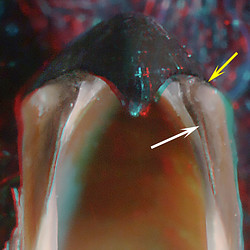
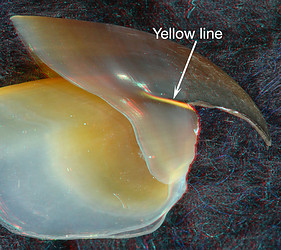
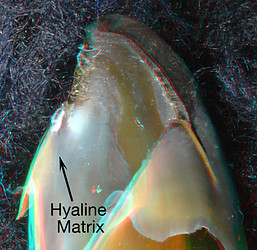


 Go to quick links
Go to quick search
Go to navigation for this section of the ToL site
Go to detailed links for the ToL site
Go to quick links
Go to quick search
Go to navigation for this section of the ToL site
Go to detailed links for the ToL site